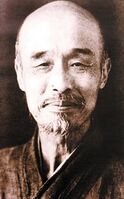Li Shutong
| PersonType | Category:Chinese Buddhist Teachers Category:Ordained (Monks and Nuns) |
|---|---|
| FirstName / namefirst | Li |
| LastName / namelast | Shutong |
| MainNamePhon | Li Shutong |
| MainNameTib | 李叔同 and 李漱筒 |
| SortName | Shutong, Li |
| bio | Hong Yi (23 October 1880 – 13 October 1942; Chinese: 弘一; pinyin: Hóngyī, also romanized Hung Yit), or Yan Yin (Chinese: 演音; pinyin: Yǎnyīn), born Li Shutong (李叔同 and 李漱筒) was a Chinese Buddhist monk, artist and art teacher. He also went by the names Wen Tao, Guang Hou, and Shu Tong, but was most commonly known by his Buddhist name, Hong Yi. He was a master painter, musician, dramatist, calligrapher, seal cutter, poet, and Buddhist monk.
He was born in Tianjin to a banking family originating in Hongtong County, Shanxi, that migrated to Tianjin in the Ming Dynasty, though his mother was from Pinghu, Zhejiang province. In 1898 Li moved to Shanghai and joined the "Shanghai Painting and Calligraphy Association,", and the "Shanghai Scholarly Society" while he was attending the Nanyang Public School (later became Jiaotong University). In 1905 Li went to Japan to study at Tokyo School of Fine Art in Ueno Park where he specialized in Western painting and music, and met a lover by the name of Yukiko who was to become his concubine. In 1910 Li returned to China and was appointed to Tianjin's Beiyang Advanced Industry School. The next year he was appointed as a music teacher in a girls' school in Shanghai. He went to Hangzhou in 1912 and became a lecturer in the Zhejiang Secondary Normal College (now Hangzhou Normal University). He taught not only Western painting and music but also art history. By 1915 Jiang Qian hired him as a teacher at Nanjing Higher Normal School (renamed in 1949 to Nanjing University), where he taught painting and music. He also taught at Zhejiang Secondary Normal School (浙江兩級師範學堂), the predecessor of the famous Hangzhou High School. During these later years, Li's reputation grew, as he became the first Chinese educator to use nude models in his painting classes, not to mention as the first teacher of Western music in China. Some of the students, like Singapore artist Chen Wen Hsi (陳文希) whom he personally groomed, went on to become accomplished masters of the arts in their later days. Li Shutong himself was also an accomplished composer and lyricist. Many of his compositions are still remembered and performed today. In 1916 [he took?] refuge in the Three Jewels of Buddhism. After spending another year there, Li began a new chapter in his life by choosing to be ordained as a monk, and thus began a holistic life dedicated to propagating Buddhism and its code of conduct. After becoming a monk he practised only calligraphy, developing a simple and unadorned, yet unique style, which was treasured by everyone who received a sample. He became known to all as Master Hong Yi. In 1942, Master Hong Yi died peacefully at the age of 61 in Quanzhou, Fujian Province. Li is one of the three great poetic monks in the late Qing Dynasty. (Others for Su Manshu, Shi Jingan). (Source Accessed July 21, 2023) |
| YearBirth | 1880 |
| YearDeath | 1942 |
| BornIn | Tianjin |
| Other wikis |
If the page does not yet exist on the remote wiki, you can paste the tag |

